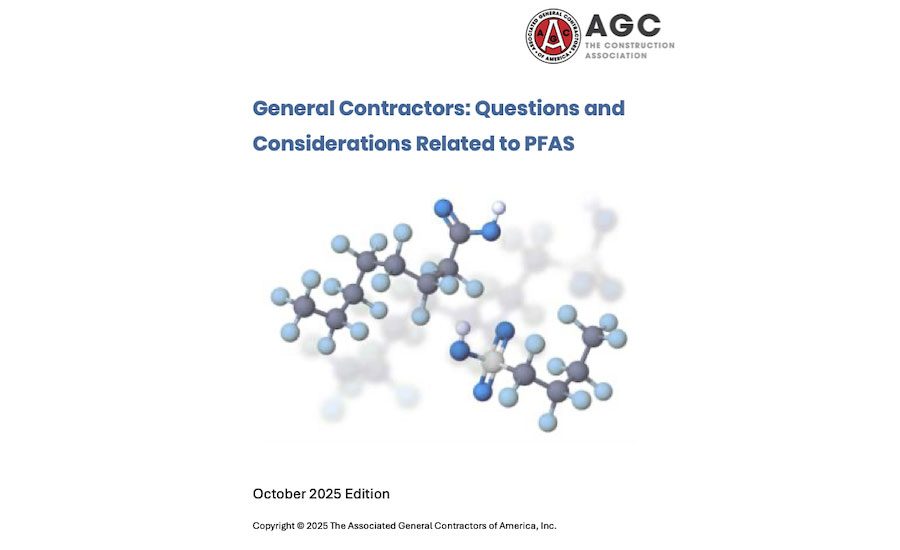According to the Associated General Contractors of America, contractors on construction sites face significant liability risks due to the Trump administration's recent decision to maintain Superfund hazardous substance designations for two PFAS substances, known as “forever chemicals.”
In September, U.S. Environmental Protection Agency Administrator Lee Zeldin said the designation of PFOA (perfluorooctanoic acid) and PFOS (perfluorooctane sulfonic acid) as “hazardous” substances under the country's Superfund law would remain in place until 2024. However, the EPA plans to initiate the regulatory process to create a uniform framework for labeling hazardous substances in the future.
“When it comes to PFOA and PFOS contamination, it remains an ongoing challenge to hold polluters accountable while providing safety for passive recipients who did not manufacture or generate these chemicals,” Zeldin said in a statement. “EPA intends to do what we can based on our existing authority, but we need new statutory language from Congress to fully address our concerns about passive recipient liability.”
The nonprofit, nonpartisan advocacy group Environmental Working Group describes PFAS as highly toxic fluorinated chemicals that accumulate in humans and do not break down in the environment. Even low doses have been linked to cancer, damage to the reproductive and immune systems and other diseases, they say.
The EPA's decision — which follows the rule that became law in April 2024 listing PFOS and PFOA under the Superfund designation — comes as uncertainty about PFAS risks leads to increased construction costs and disruptions to infrastructure projects, AGC general counsel Leah Pilconis told ENR. The rule poses significant risks for contractors because they could potentially be held liable for millions of dollars worth of cleanup of contaminated sites, regardless of their actual contribution to the contamination, she says.
“Although the construction industry does not produce PFAS, it may already be present on project sites,” Pilconis explains. “For some projects, the potential contamination risks discourage bidders, shrink the pool of qualified contractors and increase overall project costs.”
She said those costs include higher disposal fees because some landfills are now rejecting waste, forcing contractors to transport waste longer distances to specially designated hazardous waste sites. This also includes higher consulting, testing and insurance costs, as site investigations, audits and the engagement of qualified environmental law experts are expensive and insurance coverage is limited.
The EPA has issued a discretionary enforcement policy that focuses on significant polluters, Pilconis said, but contractors are not protected from lawsuits by other potentially responsible parties. Contractors are in “legal limbo” because there are no clear federal regulations or guidelines on PFAS levels in soil or groundwater that could trigger management or disposal requirements, she says, adding that no acceptable background concentration levels have been established to determine safe disposal options.
“We had members who had huge disposal costs with this that they didn’t anticipate,” Melinda Tomaino, AGC senior director of environment and sustainability, told ENR. “They have backed out of projects because the owners were not up front and didn't want to investigate and clean up the potential for this type of contamination,” she said.
Last year, AGC, along with the U.S. Chamber of Commerce and the National Waste and Recycling Association, filed a lawsuit in the federal appeals court in Washington, DC, over EPA's PFOA and PFOS designations under the Superfund law. The legal battle, which was put on hold while the government reviewed its regulatory policy, will now continue.
The coalition is asking the court to overturn the EPA's PFAS designation rule “because it was adopted unlawfully and without adequate consideration of the real-world impacts on industries such as construction,” Pilconis said.
Guide for contractors
To help contractors better understand the risks associated with PFAS on construction sites, AGC released a guidance document earlier this week.
The 13-page General Contractors: Questions and Considerations About PFAS The guide begins with a disclaimer that it is not intended as legal advice but is intended to raise questions and considerations for contractors during construction preparation and project implementation in “a rapidly evolving policy area.” The guide focuses on PFOA and PFOS and covers a range of areas including pre-tender planning, contract negotiations, project implementation and disposal.
“The federal government’s policies and rules regarding PFAS are the subject of litigation, the subject of future rulemaking, and the subject of an executive branch lawmaking project with the U.S. Congress,” AGC’s document states. In addition, states would take different and evolving measures, it said.
“We've heard more and more concerns from our members about this, and since the rule has been in effect for a year now, we wanted to make sure we included some of our members' experiences with it and some of the impacts they've seen in projects,” Tomaino said.
AGC established a PFAS task force earlier this year to discuss member concerns and help them better understand risks. The document is the result of those discussions, she said, adding that the timing for its release came shortly after the administration signaled its desire to maintain Biden-era rule.
“The questions and considerations document will hopefully get contractors thinking about what they can do in their contracts, in their bids and what they can do to protect themselves,” Tomaino said. The hope is that “they just don't walk into some kind of 'PFAS minefield' and.” [will] know what they’re doing.”
